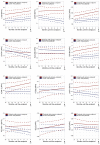Circulating Biomarkers of Cell Adhesion Predict Clinical Outcome in Patients with Chronic Heart Failure
- PMID: 31936828
- PMCID: PMC7020068
- DOI: 10.3390/jcm9010195
Circulating Biomarkers of Cell Adhesion Predict Clinical Outcome in Patients with Chronic Heart Failure
Abstract
Cardiovascular inflammation and vascular endothelial dysfunction are involved in chronic heart failure (CHF), and cellular adhesion molecules are considered to play a key role in these mechanisms. We evaluated temporal patterns of 12 blood biomarkers of cell adhesion in patients with CHF. In 263 ambulant patients, serial, tri-monthly blood samples were collected during a median follow-up of 2.2 (1.4-2.5) years. The primary endpoint (PE) was a composite of cardiovascular mortality, HF hospitalization, heart transplantation and implantation of a left ventricular assist device and was reached in 70 patients. We selected the baseline blood samples in all patients, the two samples closest to a PE, or, for event-free patients, the last sample available. In these 567 samples, associations between biomarkers and PE were investigated by joint modelling. The median age was 68 (59-76) years, with 72% men and 74% New York Heart Association class I-II. Repeatedly measured levels of Complement component C1q receptor (C1qR), Cadherin 5 (CDH5), Chitinase-3-like protein 1 (CHI3L1), Ephrin type-B receptor 4 (EPHB4), Intercellular adhesion molecule-2 (ICAM-2) and Junctional adhesion molecule A (JAM-A) were independently associated with the PE. Their rates of change also predicted clinical outcome. Level of CHI3L1 was numerically the strongest predictor with a hazard ratio (HR) (95% confidence interval) of 2.27 (1.66-3.16) per SD difference in level, followed by JAM-A (2.10, 1.42-3.23) and C1qR (1.90, 1.36-2.72), adjusted for clinical characteristics. In conclusion, temporal patterns of C1qR, CDH5, CHI3L1, EPHB4, ICAM2 and JAM-A are strongly and independently associated with clinical outcome in CHF patients.
Keywords: biomarkers; cell adhesion molecule; heart failure; repeated measurements.
Conflict of interest statement
One of the co-authors, Henk Mouthaan, is employed by Olink Proteomics.
Figures

References
Grants and funding
LinkOut - more resources
Full Text Sources
Research Materials
Miscellaneous

